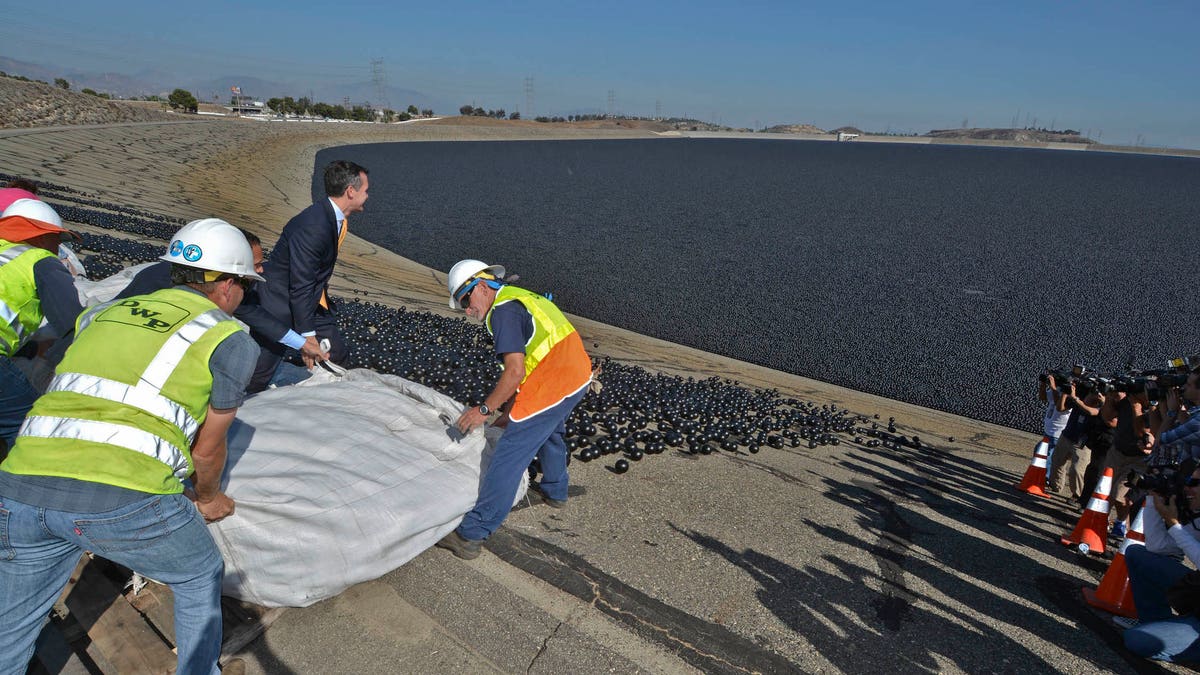Is a bevy of black balls – 96 million to be exact – a crucial solution in helping California manage its calamitous drought?
On Monday, Los Angeles mayor Eric Garcetti deployed the final 20,000 of the 96 million “shade balls” onto the surface of the city’s 175-acre, Sylmar-based reservoir, completing the final stage of the $34.5 million Los Angeles Department of Water (LADWP) attempt to protect the region’s water quality.
“In the midst of California’s historic drought, it takes bold ingenuity to maximize my goals for water conservation," Garcetti said, claiming that the initiative saves taxpayers millions. "This effort is emblematic of the kind of the creative thinking we need to meet those challenges.”
“Low-tech solutions to saving water can be just as effective as more complex ones.”
The Los Angeles Department of Water and Power is the first utility company to utilize such technology for water quality protection. Officals claim the small, plastic balls will save 300 million gallons of water from evaporating annually, stemming about 90 percent of the losses that occur through the natural process.

Los Angeles City Councilman Mitch Englander, Mayor Eric Garcetti (wearing a yellow tie) and LADWP workers deposit the final installment of 96 million shade balls into the Los Angeles Reservoir. (Art Mochizuki, LADWP)
According to LADWP, the balls will save an estimated $250 million compared to other initiatives designed to have the same effect, such as installing two floating covers or dividing the reservoir in half with a bisecting dam, which would have cost more than $300 million. The balls – which cost just 36 cents each – do not require further labor or maintenance aside from occasional rotation.
“Low-tech solutions to saving water can be just as effective as more complex ones,” Caitrin Phillips Chappelle, associate director at the Public Policy Institute of California told FoxNews.com. “Evaporation from reservoirs, especially during hot summer months, can be quite high, and reducing evaporation can be an easy way to save a large amount of water.”
However, not everyone was so enthusiastic. Nathan Krekula, biologist and operations manager at Wisconsin Diagnostic Laboratory, warned, "I don’t believe that in the long run this provides a good strategy in protecting the water. I believe that this will increase evaporations due to a greater surface area as well as providing a great place for bacteria to have a nice environment to grow protected from UV light that kills it.
"This system will require greater levels of water treatment that in the long run will require more money to ensure public safety," he said.
Retired LADWP biologist Brian White is credited as the brainchild behind the use of the shade balls for water protection, the concept coming to him when he learned about the application of “bird balls” in ponds along airfield runways.
The balls being used in Los Angeles are made of high density polyethylene, the same material gallon milk containers are made of. A city official told FoxNews.com the balls will not leach chemicals or affect water temperatures.
The state of California has been embroiled in a catastrophic drought for more than four years, with Gov. Jerry Brown declaring the water crisis a state of emergency in January, 2014. The period between 2011 and 2014 marks the driest since record-keeping began in 1895.





















